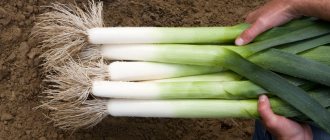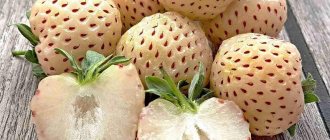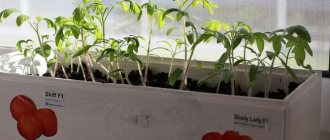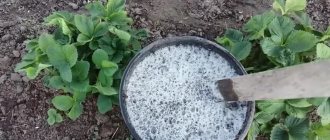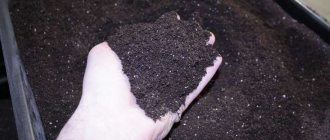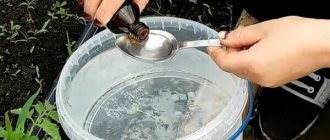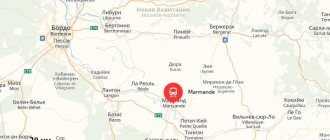The complex plant nutrition product Kristalon is rightfully considered a new generation of agricultural technology. This fertilizer is optimized for use in personal and commercial farms with manual or partially mechanized labor, as well as in indoor gardening. Manufactured by Fertika and Yara; the principles of synthesis of the finished mixture (see below) are similar in both cases, and the percentage composition and order of use of most drugs are the same.
Note: for a video review of Kristalon complex mineral fertilizers, see the story:
Why is it new?
Kristalon fertilizer belongs to the new generation not thanks to the many varieties (see figure), which allow inexperienced plant growers to choose fertilizer for their pets according to the “pharmacy” principle: “I need something for my heart”, “I need something for shortness of breath”, and etc. And not thanks to the convenient packaging, which takes into account the demand of literally all users, from the indoor flower grower to the owner of several commercial hectares. And not thanks to the water-soluble crystalline formulation, which makes dosing easier and easier. Crystalon has gained its popularity because meso- and microelements of plant nutrition are presented in it in chelated forms.
Forms of release of Kristalon fertilizer
Note: Fertika Kristalon, specialized for individual crops or their communities (coniferous, lawn, citrus, etc.), is also available in the form of a water-soluble concentrate VRK. The bottle cap is a measuring container. It is diluted in the volume of water indicated on the label - and that’s all it takes.
What are chelates
How chelated chemical compounds are formed is shown in Fig. below. Chelating agents are most often harmless organic substances of a fairly simple composition, which in nature decompose into carbon, oxygen and hydrogen and do not produce after-effects for the environment. Under certain conditions, chelating agents are combined into a kind of ring or “trap” of a more complex configuration, the so-called. coordination chemical bonds (the old name is polar or hydrogen). The anomalous properties of water, which make it a living environment, are due to the fact that any volume of its liquid form is additionally held together by many coordination bonds between molecules. Coordination bonds are much weaker than ionic and covalent bonds, and in a pure solution of the agent, chelating “traps” disintegrate as quickly as they are formed.
It is a different matter if the solution contains an admixture of ions or atoms of a substance that is also capable of forming coordination bonds (Me in the figure). In this case, “the whole company” comes together into a fairly stable complex, which is the chelate. In solution, the ratio of chelates and their initial components is determined by the laws of chemical equilibrium. If chelates are removed from the medium, then according to the laws of the same equilibrium the reaction will shift towards their further formation. In principle, in this way it is possible to chelate all the starting reagents and obtain a pure chelate, which will behave in many ways like substances formed by ordinary chemical bonds, for example. crystallize.
Why do plants need chelates?
The value of chelates as fertilizers lies primarily in the fact that nutrients are delivered to plants in the chemically active form they need (in agrochemical terminology, mobile) form. If such substances are introduced in the form of ordinary substances, but most of the plant nutrients will be “intercepted” and neutralized by other components of natural communities before reaching their destination. A classic example is iron, which is involved in plant biosynthesis. In nature there is more than enough of it, but in the form of Fe(III) ion, which plants do not absorb. And the Fe(II) they need very quickly reacts with anything, turning into Fe(III). Therefore, many indoor plant lovers prepare iron and copper chelates from respectively. vitriol and citric acid, but even for a plot of a couple of acres this is difficult and expensive, and not everything can be chelated at home.
What is the value of Crystalon
Results of using chelated fertilizers for grains
Farmers around the world have long been “sharpening their teeth” on chelated fertilizers: their use makes it possible to increase the yield of the same areas under the same conditions to such an extent that specialists’ eyes pop out of their heads. And for a complete amateur, it’s easy to imagine what it means to increase the yield of, say, grains by 20-50% without additional plowing (!), for which there is no longer room, see Fig. on right.
Plus:
- The possibility of “jewelry” regulation of plant growth without any stimulants, genome modification, etc., only by delivering the nutrients they need exactly at a given phase of development in exactly the required quantity. It is impossible to accurately dose, for example, phosphorus, without at the same time avoiding excess or deficiency of nitrogen and potassium, with mineral fertilizers - there are no such substances.
- As a result, environmental friendliness, because the accumulation in nature of nitrates, phosphates, compounds of ballast components of fertilizers (for example, chlorine) is excluded.
- Speed of action and, as a consequence, reduction of dosages, etc. expenses for fertilizers, because Loss of active substances during migration is practically eliminated.
Everything would be fine, but... chelates are not stable enough during storage and, especially, in tank mixtures: there is no escaping the laws of chemical equilibrium. If tank mixtures of mineral fertilizers remain suitable for use for days, then chelates last for hours. That is, by the time the tractor with the spreader or sprayer reaches the edge of the field, the chelate mixture will have time to become unusable. In addition, chelates are still quite expensive and do not yet pay for themselves on large areas. But the developers of Kristalin managed to select such chelating agents and synthesis methods that the result was a fertilizer that was profitable in small areas and suitable for use on them: the shelf life of Kristalin working solutions is 6 hours.
Note: literally fantastic results are shown in experiments on feeding plants with amino acid-based products, but, alas, this is a matter for the future - the shelf life of working solutions is calculated in minutes.
Characteristics of Kristalon fertilizer
All microelements included in the Kristalon series fertilizers are presented in chelated form, that is, they are instantly absorbed by the plant. It is microelements that improve metabolism and promote the process of active photosynthesis. In addition, Kristalon does not contain chlorine, which, if used in excess, can cause burns on plant leaves.
Crystalon contains:
- NPK complex. It consists of elements important for plant development such as nitrogen, potassium and phosphorus;
- magic;
- sulfur;
- trace elements: iron, boron, manganese, molybdenum, copper, zinc.
Crystalon goes on sale in plastic containers weighing 20 g, 100 g and 800 g, as well as in 25-kilogram bags.
Safety
Kristalon fertilizers are substances of the 4th hazard class. When working with them, basic precautions are sufficient: gloves on hands, safety glasses on eyes; for spraying - a gauze bandage and a hat. Allowable working time with drugs is 6 hours. Do not drink, eat or smoke while working. If the substance gets on the body, rinse with water; In case of contact with eyes, rinse them open under running water. If signs of illness and/or ingestion occur, stop working, empty your stomach and consult a doctor.
Reviews
Gardeners testify that the use of “Kristalon”:
- Compensates for missing nutrients at all stages of development, from emergence to harvest.
- Increases cold resistance and drought resistance.
- Accelerates growth power.
- Helps the plant receive useful substances when, due to weather conditions or other reasons, the root system cannot cope with its task.
- Promotes early ripening of fruits.
- Improves their appearance and quality.
Where to specialize?
The Kristalon fertilizer lines are generally specialized in 2 areas. The first is preparations for individual cultures and their communities. These are Crystal Tomato, Flower, Lawn, etc., except for Cucumber (see below). Plant-directed Crystals are used according to the instructions on the package and are profitable only for monocultures of closed ground, and only due to high winter prices for fresh vegetables. Therefore, more or less experienced greenhouse owners prefer to feed plants with Crystals aimed at individual phases of their development, taking into account the peculiarities of cultivation. These are the so-called colored Crystals, because... they are marked with color marks on the packaging and go on sale under the appropriate conditions. names. This also includes Cucumber Crystal, because... it is suitable for any pumpkin in a greenhouse, in open ground in small strips and in melon fields.
Composition and purpose
The percentage composition of Kristalon fertilizers is given in table. below. All preparations include a full complex of basic nutrition NPK, mesoelements magnesium and sulfur (the first - except for Yellow) and a set of microelements. The third most important meso-element, calcium, is missing. The reason is the rather high acidity of the preparations (far right column), which requires regular liming of the soil with limestone flour when used systematically. It is impossible to deoxidize the soil after Crystalline with dolomite flour, because dolomite contains magnesium instead of calcium.
Features of colors
The purpose and dosage of Kristalon fertilizers are as follows:
- Universal (Green, Special, Special) – feeding during the growing season and foliar feeding. Dosage for watering: 10-20 g per bucket of water before flowering, 5-10 g per bucket after flowering. The dosage for feeding leaves is 5 g per 5 liters of water (0.1% solution, i.e. 10 g is needed in a 10-liter sprayer tank).
- White - intended for feeding vegetables and flowers during the flowering period. Dose for watering 10-15 g per bucket, for spraying 0.1% solution.
- Brown – intended primarily for bulbous and root vegetables, because stimulates the growth of underground parts. In dry places it is useful for tomatoes, melons and other crops with a shallow root system. Dosage 10-15 g per bucket for watering, 0.1% solution for spraying.
- Red – stimulates flowering and ovary formation. Not recommended for root vegetables and greens. Dosage 15-20 g per bucket for watering, 0.2% solution for foliar feeding.
- Scarlet (pink) - used together with Universal in rainy years and on loose, magnesium-poor soils (if magnesium chlorosis is systematically observed in plants). Dosage 10-20 g per watering bucket, 0.15%-0.2% spray solution.
- Orange - used to reduce the fall of fruit and vegetable ovaries by spraying with a 0.2% solution.
- Yellow - used on heavy, poorly structured soils together with or instead of Universal. Dosages are the same as for Universal.
- Cucumber (light green marking) – for pumpkin in any cultivation conditions. Dosage 10-20 g per bucket, watering, 0.1%-0.2% solution of foliar feeding.
- Blue - stimulates the growth of underground parts and green mass on fairly fertile and structured soils. Recommended for root vegetables and green vegetables instead of Universal or in alternation with it.
Note: for more information on choosing Fertik fertilizers, see the video:
Video: about Fertik fertilizers
Advantages of the Kristalon line fertilizers
- Environmentally friendly fertilizer;
- Contains approximately 95% useful elements;
- Cost-effective;
- It has a beneficial effect on the green mass of plants, promotes resistance to adverse weather conditions, and increases immunity to various fungal diseases;
- Helps increase yield, improves fruit quality;
- Flower crops begin to bloom profusely and brightly;
- Combines well with other organo-mineral fertilizers;
- Helps reduce the degree of negative impact of pesticides on crops;
- Completely soluble in water.
Application procedure
The use of complex fertilizer Kristalon according to standard schemes is not difficult:
- In open ground under normal conditions - fertilizing watering once every 2 weeks.
At temperatures above 25 degrees, watering alternates with foliar feeding.- In the greenhouse, after every 3 regular waterings, fertilizing is carried out, but not more than once every 10 days.
- On open and protected ground, when signs of starvation appear on any element, foliar feeding is carried out accordingly every 7-10 times. drug.
Double major
Kristalon “colored” fertilizers are more effective if they are “tied” to specific crops. In this case, the yield increase can be comparable to that from expensive growth stimulants. With two small differences: at least the plants will not deplete the soil and will provide full-fledged seed material for the trail. season.
Seedling
Complex feeding of seedlings with Critalons is carried out by watering with a 0.2% solution (2 g per 1 liter of water) according to the following scheme:
- Immediately after the pick and twice more with an interval of 7-10 days - Yellow.
- The fourth watering of seedlings illuminated with phytolamps - Blue.
- Indoor seedlings without lighting at daytime temperatures up to 17-18 degrees - White.
- The same, at 18-22 degrees - Universal.
- The same, with daytime temperatures above 25 degrees - Red.
Potato
Potatoes are watered with Kristalon 20 g per bucket in favorable years and 10-15 g per bucket in unfavorable years. Before flowering, use Yellow; during it and after Brown. The frequency of watering is once every 2 weeks.
Tomatoes
Crystalon for watering tomatoes is diluted 20 g per bucket of water. The frequency of watering is also once every 2 weeks. Alternation of drugs:
- Before budding begins - Blue.
- From the beginning of budding to pea-sized ovaries - Red.
- From pea-sized ovaries to the beginning of fruit coloring - White.
- Next, before the harvest begins, Brown.
Fruit and berry
Fruit trees and shrubs are watered for the first time with Kristalon Universal at a concentration of 20 g per 10 sq. m. m of leaf area along the flower cone (with the beginning of bud opening). Then they also water with Universal every time 2-3 days after applying plant protection products (plant protection products) in a concentration reduced by half (10 g per 10 sq. m of crown or bush).
Grape
Watering twice at a concentration of 20 g per bucket of water. While pouring the ovaries into the berries, pour Yellow; at the beginning of coloring the berries Brown.
Legumes
The concentration of the irrigation solution is 20 g per bucket in favorable years and 10 g per bucket in unfavorable years. When throwing out the mustache, water it with Yellow; at the beginning of the formation of Beans by the Universal.
Corn (maize)
The concentration of the solution is 30 g/10 l of water in favorable years and 20 g/10 l in unfavorable years. Watering with Kristalon Universal at the stages of 3-5 and 5-7 leaves.
Note: for corn and other plants with the so-called. With Kranz syndrome, favorable years are dry and hot, and humid, moderately warm years are unfavorable.
Indoor
Potted crops are watered with Crystal depending on the nature of their decorative properties and cultivation conditions:
- Flowers, succulents, etc. that require a minimum amount of nutrition are watered with Crystalno Red once every 2-3 weeks at a concentration of 0.8 g per 1 water. Watering begins with the appearance of the first shoots of this season (peduncles, vegetative ones, it doesn’t matter). Cacti begin to be watered after the first baby appears. After flowering has finished, fertilizing watering is stopped until the next day. awakening.
- During the growing season, deciduous and ornamental plants are watered with the same frequency with Crystal Blue at a concentration of 1 g/1 liter of water. During the dormant period, evergreens are maintained by watering once every 1-1.5 months. Crithalon White 0.5 g/1 l of water.
- Transplanted (not overloaded with a clod of earth!) deciduous indoor plants and rooted cuttings are watered with Crystal Yellow 4 times: the first 2 in a concentration of 1 g/1 l of water. The first - 2-3 days after transplanting or planting the cuttings in place; the second one a week later. 3rd watering after another week at half the concentration (0.5 g/1 liter of water), and the final watering after another 2 weeks also at half the concentration.
- The same, succulents, and especially aloe vera, as well as most euphorbias: one watering at half concentration 3-4 days after planting; the second after 2 weeks is also at half concentration. Do not overdo it, otherwise the neck will become soggy and the plant will collapse irreversibly!
Advantages and disadvantages
Varieties of "Kristalon" have the following advantages:
- applied to all crops;
- can be used both in the fields and in private farms;
- root and foliar application;
- application in drip irrigation systems;
- perfectly accepted by plants.
Cons: high consumption of solution.
Description of the drug Plantafol
Designed for foliar feeding - completely soluble in water, supplies the soil and plant with a sufficient amount of vitamins, macro and microelements. All this provides the plant with sufficient nutrition, full growth and development of the plant, formation of fruits, and their high quality.
According to the instructions, it is permissible to mix with other pesticides - its effectiveness is ensured by the PAFs and large amounts of phosphorus included in its composition.
In what cases is the drug prescribed?
Agronomists recommend using this composition in the following cases:
- With low activity, growth and formation of the root system.
- With insufficient soil aeration, the presence of pathogenic microflora in it and low levels of nutritional components and vermicompost.
- If the pH level in the soil is insufficient, then there is an increased level of humidity, drought, and low temperature conditions.
- Allows you to accelerate the ovary and its quality due to the high content of nutritional components.
When should the product be used?
Depending on the type of composition, it can be used in a variety of periods of plant growth - from the planting stage to the formation of fruits. In this case, everything depends on the labeling of the drug and the ratio of nitrogen and potassium, as well as phosphorus.
Composition of the drug
In addition to such main components as nitrogen and phosphorus, as well as potassium, the composition, depending on the labeling, also includes other components:
- Up to 6% nitrate and ammonium ions.
- Phosphoric anhydride, as well as amino group compounds.
- Potassium oxides and complex microelements.
Drug labeling
When choosing, it is worth considering its labeling:
- 30 10 10 – nitrogen predominates in the composition. It is used in the stage of active vegetation and growth, plant formation.
- 10 54 10 – a composition with a high phosphorus content and is used at the stage of the plant knocking out buds and the root system. They are recommended to feed green masses before/during the period of immediate flowering.
- 0 25 50 is a composition that actively forms the ovary on the plant, and therefore it is actively used at the flowering stage.
- 5 15 45 – a composition with a high potassium content, which accelerates metabolic processes in the plant, the growth and development of fruits, making it possible to perfectly strengthen the plant’s immunity and enhance its resistance to pathogenic microorganisms.
- 20 20 20 composition with an optimal combination of all nutritional compounds necessary for the plant. Due to its versatility, it can be used at any stage of plant formation and development.
Composition of the nutritional mixture
In appearance, the fertilizer resembles crystals and dissolves well in water without forming sediment. Includes:
Plants at each stage of development need different elements. For example, in the spring, when green mass is actively growing, nitrogen is most needed. During flowering and fruiting - phosphorus and potassium. Therefore, the composition is formed in such a way that at any time of the year you can buy Crystal, which corresponds to the stage of development of the culture.
Saturation occurs quickly, especially if used for foliar feeding. According to reviews, Kristalon fertilizer tidies up the appearance of the plant in 2–3 days.
Agrochemical features of the product
Kristalon is a safe and chemically pure fertilizer that contributes to the production of environmentally friendly products. These products significantly improve the stress resistance of plants to factors that appear under the influence of pesticides, fungal diseases or bad weather conditions, etc. They also significantly increase the yield and quality of grown crops. Experts note that thanks to Kristalon:
- plants are quickly saturated with all vital macro- and microelements;
- the composition of the soil is regulated and the mineral nutrition of plants is improved;
- biochemical processes are activated in crops, which has a positive effect on yield.
This type of fertilizer goes well with growth stimulants and pesticides. And when used in irrigation systems, it does not react with the soil colloidal complex. The use of these mineral additives significantly increases productivity, has a beneficial effect on the formation of healthy fruits, and promotes earlier and more abundant flowering of indoor and garden flowers.
